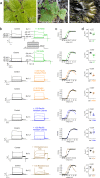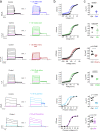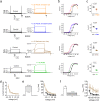Native American ataxia medicines rescue ataxia-linked mutant potassium channel activity via binding to the voltage sensing domain
- PMID: 37280215
- PMCID: PMC10244465
- DOI: 10.1038/s41467-023-38834-6
Native American ataxia medicines rescue ataxia-linked mutant potassium channel activity via binding to the voltage sensing domain
Abstract
There are currently no drugs known to rescue the function of Kv1.1 voltage-gated potassium channels carrying loss-of-function sequence variants underlying the inherited movement disorder, Episodic Ataxia 1 (EA1). The Kwakwaka'wakw First Nations of the Pacific Northwest Coast used Fucus gardneri (bladderwrack kelp), Physocarpus capitatus (Pacific ninebark) and Urtica dioica (common nettle) to treat locomotor ataxia. Here, we show that extracts of these plants enhance wild-type Kv1.1 current, especially at subthreshold potentials. Screening of their constituents revealed that gallic acid and tannic acid similarly augment wild-type Kv1.1 current, with submicromolar potency. Crucially, the extracts and their constituents also enhance activity of Kv1.1 channels containing EA1-linked sequence variants. Molecular dynamics simulations reveal that gallic acid augments Kv1.1 activity via a small-molecule binding site in the extracellular S1-S2 linker. Thus, traditional Native American ataxia treatments utilize a molecular mechanistic foundation that can inform small-molecule approaches to therapeutically correcting EA1 and potentially other Kv1.1-linked channelopathies.
© 2023. The Author(s).
Conflict of interest statement
The authors declare no competing interests.
Figures










Similar articles
-
A conifer metabolite corrects episodic ataxia type 1 by voltage sensor-mediated ligand activation of Kv1.1.Proc Natl Acad Sci U S A. 2025 Jan 14;122(2):e2411816122. doi: 10.1073/pnas.2411816122. Epub 2024 Dec 30. Proc Natl Acad Sci U S A. 2025. PMID: 39793113 Free PMC article.
-
The episodic ataxia type 1 mutation I262T alters voltage-dependent gating and disrupts protein biosynthesis of human Kv1.1 potassium channels.Sci Rep. 2016 Jan 18;6:19378. doi: 10.1038/srep19378. Sci Rep. 2016. PMID: 26778656 Free PMC article.
-
A channelopathy mutation in the voltage-sensor discloses contributions of a conserved phenylalanine to gating properties of Kv1.1 channels and ataxia.Sci Rep. 2017 Jul 4;7(1):4583. doi: 10.1038/s41598-017-03041-z. Sci Rep. 2017. PMID: 28676720 Free PMC article.
-
Kv1.1 Channelopathies: Pathophysiological Mechanisms and Therapeutic Approaches.Int J Mol Sci. 2020 Apr 22;21(8):2935. doi: 10.3390/ijms21082935. Int J Mol Sci. 2020. PMID: 32331416 Free PMC article. Review.
-
Clinical Spectrum of KCNA1 Mutations: New Insights into Episodic Ataxia and Epilepsy Comorbidity.Int J Mol Sci. 2020 Apr 17;21(8):2802. doi: 10.3390/ijms21082802. Int J Mol Sci. 2020. PMID: 32316562 Free PMC article. Review.
Cited by
-
Discovery of a potent, Kv7.3-selective potassium channel opener from a Polynesian traditional botanical anticonvulsant.Commun Chem. 2024 Oct 10;7(1):233. doi: 10.1038/s42004-024-01318-9. Commun Chem. 2024. PMID: 39390220 Free PMC article.
-
Potential Benefit of Channel Activators in Loss-of-Function Primary Potassium Channelopathies Causing Heredoataxia.Cerebellum. 2024 Apr;23(2):833-837. doi: 10.1007/s12311-023-01584-8. Epub 2023 Jul 17. Cerebellum. 2024. PMID: 37460907 Review.
-
A conifer metabolite corrects episodic ataxia type 1 by voltage sensor-mediated ligand activation of Kv1.1.Proc Natl Acad Sci U S A. 2025 Jan 14;122(2):e2411816122. doi: 10.1073/pnas.2411816122. Epub 2024 Dec 30. Proc Natl Acad Sci U S A. 2025. PMID: 39793113 Free PMC article.
-
Urtica dioica: Anticancer Properties and Other Systemic Health Benefits from In Vitro to Clinical Trials.Int J Mol Sci. 2024 Jul 8;25(13):7501. doi: 10.3390/ijms25137501. Int J Mol Sci. 2024. PMID: 39000608 Free PMC article. Review.
-
Polymodal K+ channel modulation contributes to dual analgesic and anti-inflammatory actions of traditional botanical medicines.Commun Biol. 2024 Aug 28;7(1):1059. doi: 10.1038/s42003-024-06752-y. Commun Biol. 2024. PMID: 39198706 Free PMC article.
References
-
- Hasan, S. M. & D’Adamo, M. C. In GeneReviews((R)) (eds. Adam, M. P. et al.) (University of Washington, Seattle, 1993). - PubMed

